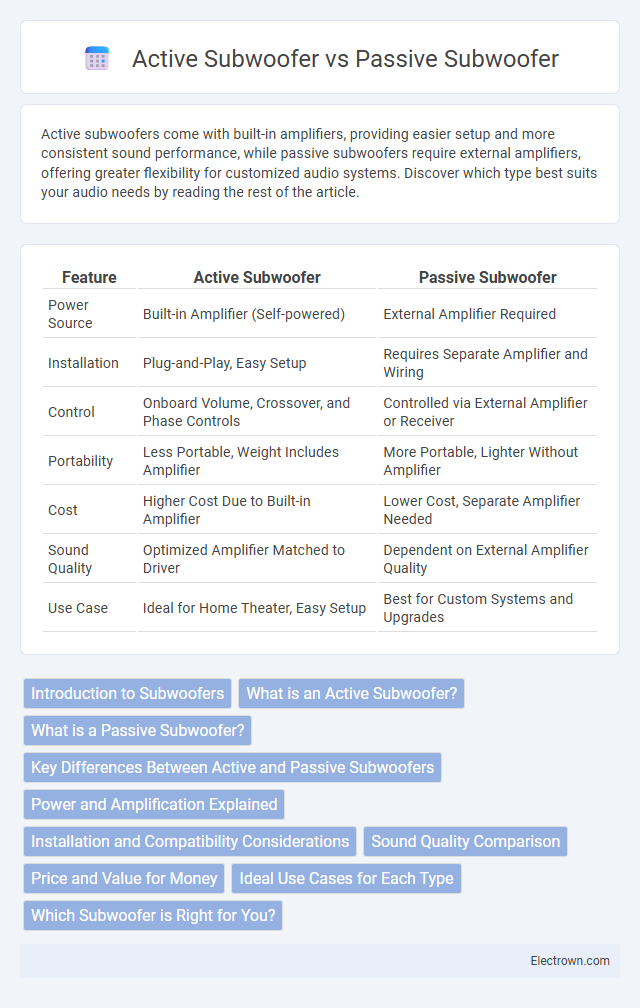Active subwoofers come with built-in amplifiers, providing easier setup and more consistent sound performance, while passive subwoofers require external amplifiers, offering greater flexibility for customized audio systems. Discover which type best suits your audio needs by reading the rest of the article.
Table of Comparison
| Feature | Active Subwoofer | Passive Subwoofer |
|---|---|---|
| Power Source | Built-in Amplifier (Self-powered) | External Amplifier Required |
| Installation | Plug-and-Play, Easy Setup | Requires Separate Amplifier and Wiring |
| Control | Onboard Volume, Crossover, and Phase Controls | Controlled via External Amplifier or Receiver |
| Portability | Less Portable, Weight Includes Amplifier | More Portable, Lighter Without Amplifier |
| Cost | Higher Cost Due to Built-in Amplifier | Lower Cost, Separate Amplifier Needed |
| Sound Quality | Optimized Amplifier Matched to Driver | Dependent on External Amplifier Quality |
| Use Case | Ideal for Home Theater, Easy Setup | Best for Custom Systems and Upgrades |
Introduction to Subwoofers
Subwoofers enhance audio systems by reproducing low-frequency sounds, providing deep bass that standard speakers often lack. Active subwoofers include built-in amplifiers, simplifying setup and ensuring optimal power matching with the driver. Passive subwoofers require external amplifiers, allowing greater flexibility in amplification choices but necessitating more complex installation.
What is an Active Subwoofer?
An active subwoofer includes a built-in amplifier, allowing it to process audio signals and power the speaker independently without requiring an external amplifier. This integration simplifies setup and ensures optimal performance tailored to the subwoofer's specifications. Active subwoofers often feature adjustable crossover frequencies and volume controls, enhancing customization for home theater or music systems.
What is a Passive Subwoofer?
A passive subwoofer requires an external amplifier to power its speaker, as it does not contain a built-in amplifier like an active subwoofer. It connects to your home theater receiver or dedicated amplifier, allowing for flexible placement and customization based on your audio setup. Passive subwoofers typically offer greater control over sound tuning but demand additional equipment and wiring.
Key Differences Between Active and Passive Subwoofers
Active subwoofers feature built-in amplifiers, enabling direct connection to audio sources without the need for external equipment, while passive subwoofers require an external amplifier to power them. Active models offer easier setup, precise tuning options, and integrated crossover controls, whereas passive subwoofers provide more flexibility in amplifier choice and system customization. The efficiency and convenience of active subwoofers suit most home and professional setups, while passive subwoofers are preferred by audiophiles seeking tailored amplification solutions.
Power and Amplification Explained
Active subwoofers feature built-in amplifiers tailored to their drivers, delivering optimized power output and simplified installation by eliminating the need for external amplification. Passive subwoofers rely on external amplifiers, requiring separate power sources and precise matching of amplifier wattage to ensure efficient performance and prevent damage. The integrated amplification in active subwoofers enhances frequency response and dynamic range, whereas passive systems offer flexibility in amplifier choice but demand careful consideration for optimal sound quality.
Installation and Compatibility Considerations
Active subwoofers feature built-in amplifiers, simplifying installation by requiring only a line-level audio connection and power outlet, making them highly compatible with most home theater and audio systems. Passive subwoofers demand external amplifiers, adding complexity to installation and requiring careful matching of amplifier power and impedance to ensure optimal performance. Your choice depends on your system setup and ease of installation preferences, with active models offering plug-and-play convenience and passive models allowing for more customizable configurations.
Sound Quality Comparison
Active subwoofers deliver superior sound quality due to their built-in amplifiers, which are precisely matched to the driver, ensuring optimal power handling and reduced distortion. Passive subwoofers rely on external amplifiers, making their sound quality dependent on amplifier matching and potentially leading to signal loss or inconsistent performance. Frequency response in active units tends to be more accurate and controlled, resulting in clearer bass reproduction compared to passive models.
Price and Value for Money
Active subwoofers generally cost more upfront due to built-in amplifiers, offering better convenience and integration, which provides excellent value for money when ease of use and compactness are priorities. Passive subwoofers require separate amplifiers, making initial investments potentially lower but often resulting in higher total costs when including external equipment, suitable for those seeking customizable setups with possibly better long-term upgrade options. Consumers valuing price efficiency and simplicity tend to prefer active subwoofers, while audiophiles who want flexibility and scalability might find passive subwoofers offer superior overall value.
Ideal Use Cases for Each Type
Active subwoofers are ideal for home theaters and professional audio setups where built-in amplifiers provide convenience and precise power matching, ensuring optimal sound quality without external equipment. Passive subwoofers suit custom audio systems and car audio applications where separate amplifiers allow for flexible power upgrades and tailored integration with existing components. Choosing between active and passive subwoofers depends on the desired level of control, installation complexity, and system compatibility.
Which Subwoofer is Right for You?
Active subwoofers feature built-in amplifiers, providing plug-and-play convenience and precise power matching for optimal bass performance, making them ideal for users seeking easy setup and consistent sound quality. Passive subwoofers require external amplifiers, offering greater flexibility for customization and integration into advanced audio systems, preferred by audiophiles who want tailored sound control. Choosing between active and passive subwoofers depends on your technical expertise, budget, and whether you prioritize simplicity or customization in your audio setup.
active subwoofer vs passive subwoofer Infographic

 electrown.com
electrown.com